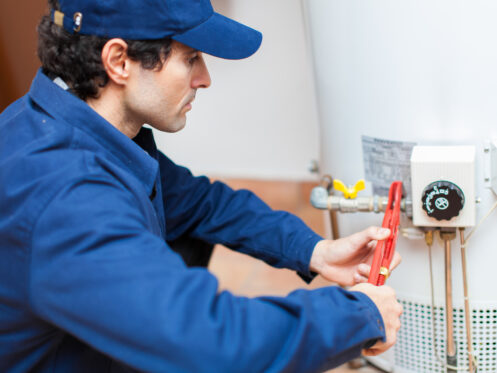No matter what type of water heater you have, it must be flushed out regularly. Traditional tank-style and tankless water heaters should be flushed once or twice a year, but the reasons for doing so are slightly different for each type of unit. In today’s post, we will discuss why flushing your water heater is so important, the benefits flushing provides, and how to do it.
How Flushing Benefits a Tank-Style Water Heater
All tank-style water heaters should be flushed at least once every six to 12 months to remove all the sediment that naturally builds up inside the unit’s tank. Water contains dissolved minerals like calcium and magnesium. Even if your home doesn’t have hard water, there are still at least some minerals present. These minerals dissolve in the water, so you can’t see them. When the water is heated, it causes some of the minerals to precipitate, meaning they are no longer dissolved and suspended. Instead, they solidify into hard chunks of sediment that settle to the bottom of the water heater tank.
Unless the water heater is drained and flushed regularly, the sediment layer in the tank can build up to the point that it begins to hamper the unit’s performance. The specific issues that sediment can cause vary depending on whether the unit is powered by gas or electricity.
In a gas water heater, most of the heat disperses into the water via a large gas burner that sits directly underneath the tank. The combustion fumes produced by the burner are extremely hot, and some of this heat transfers to the water from the exhaust flue that runs through the middle of the tank. Still, most of the heat passes from the burner to the metal burner plate, and then it flows into the water.
When there is lots of sediment in the bottom of the tank, it insulates the burner plate and absorbs most of the heat from the burner instead of allowing it to flow into the water. This causes the water in the tank to heat up much more slowly, which means the unit will stay on for long periods and use more energy.
Another issue is that all of the heat absorbed by the sediment can create hot spots that weaken the steel tank and cause it to corrode. In some cases, it can start leaking. If this happens, you must replace the entire water heater with a new unit.
Sediment build-up can also negatively impact the performance of electric tank-style water heaters. Unlike gas units, electric water heaters don’t just heat from the bottom. Instead, they have one electric heating element near the very bottom of the tank and a second heating element near the middle of the tank.
If the lower heating element is covered in sediment, the sediment will absorb most of the heat, preventing the heat from reaching the water. When this occurs, the unit will have longer run and recovery times. It will also use more energy, even if the middle heating element is functioning properly. In addition, sediment can cause the lower heating element to wear out more quickly, requiring a replacement.
The Importance of Flushing and Cleaning a Tankless Water Heater
Sediment build-up isn’t an issue for tankless water heaters because they don’t store hot water like tank-style units. That said, the reason tankless water heaters need to be flushed and cleaned still involves all of the minerals in the water.
Both gas and electric tankless units have a metal heat exchanger that absorbs heat from either the gas burner or electric resistance coil and then transfers this heat to the water as it flows through the unit. As water flows through the unit, some dissolved minerals are always left behind and will start to form a hard layer that can coat the heat exchanger. As the limescale builds up, it will insulate the heat exchanger to where the water flowing through the unit no longer comes into direct contact with the metal. This results in less heat flowing out of the heat exchanger into the water, and your water may not get hot enough.
The only way to prevent this problem is to flush and clean your hot water heater. Cleaning the water heater involves running a descaling solution through the unit to dissolve and flush out all the limescale and mineral deposits. This is something you should do twice a year, especially if your home has very hard water.
Can You Flush a Water Heater on Your Own?
Flushing a tankless water heater is something you should usually hire a plumber for because it requires using a pump to force the descaling solution through the unit. If you have a tank-style hot water heater, it is possible to drain and flush it yourself. However, we would still recommend leaving this job to the professionals for one important reason. The reason is that you should also have your water heater professionally inspected and maintained every year. Since this process requires draining the tank, it makes sense to have the plumber flush the unit during your inspection.
Before flushing a tank water heater, shut the unit off for at least a few hours, or preferably overnight, so the water has time to cool. Draining the unit when the water is still hot is always a bad idea due to the risk of scalding.
Once the water has sufficiently cooled, a hose is attached to the drain valve near the bottom of the tank. After shutting off the valve on the cold water inlet pipe so no more water can flow into the unit, the drain valve is opened to drain the water outside or into a floor drain. Next, the inlet valve is reopened to allow water to flow back into the tank, and the unit is then flushed until no more sediment comes out.
In many cases, the drain valve will continually become clogged with sediment during the flushing process. In fact, these clogs can be so severe that the only solution is to replace the entire drain valve. Replacing the drain valve is typically not something you can do on your own, so this is another reason why it is always best to have a plumber flush your hot water heater for you.
If you need your water heater flushed or are in need of any other water heater service, Dream Team Home Services is here to help. We install, maintain, and repair tank-style and tankless water heaters. We also offer a range of other plumbing, heating, cooling, and electrical services for customers in Media, Haverton, Pioli, and the surrounding areas. HVAC installation, maintenance, and repair; sewer repair and trenchless sewer lines; rewiring and home generators; and indoor air quality checks are only a few services we provide to our valued clients. To schedule an appointment or to inquire about what we do, contact our expert team at Dream Team Home Services today.



